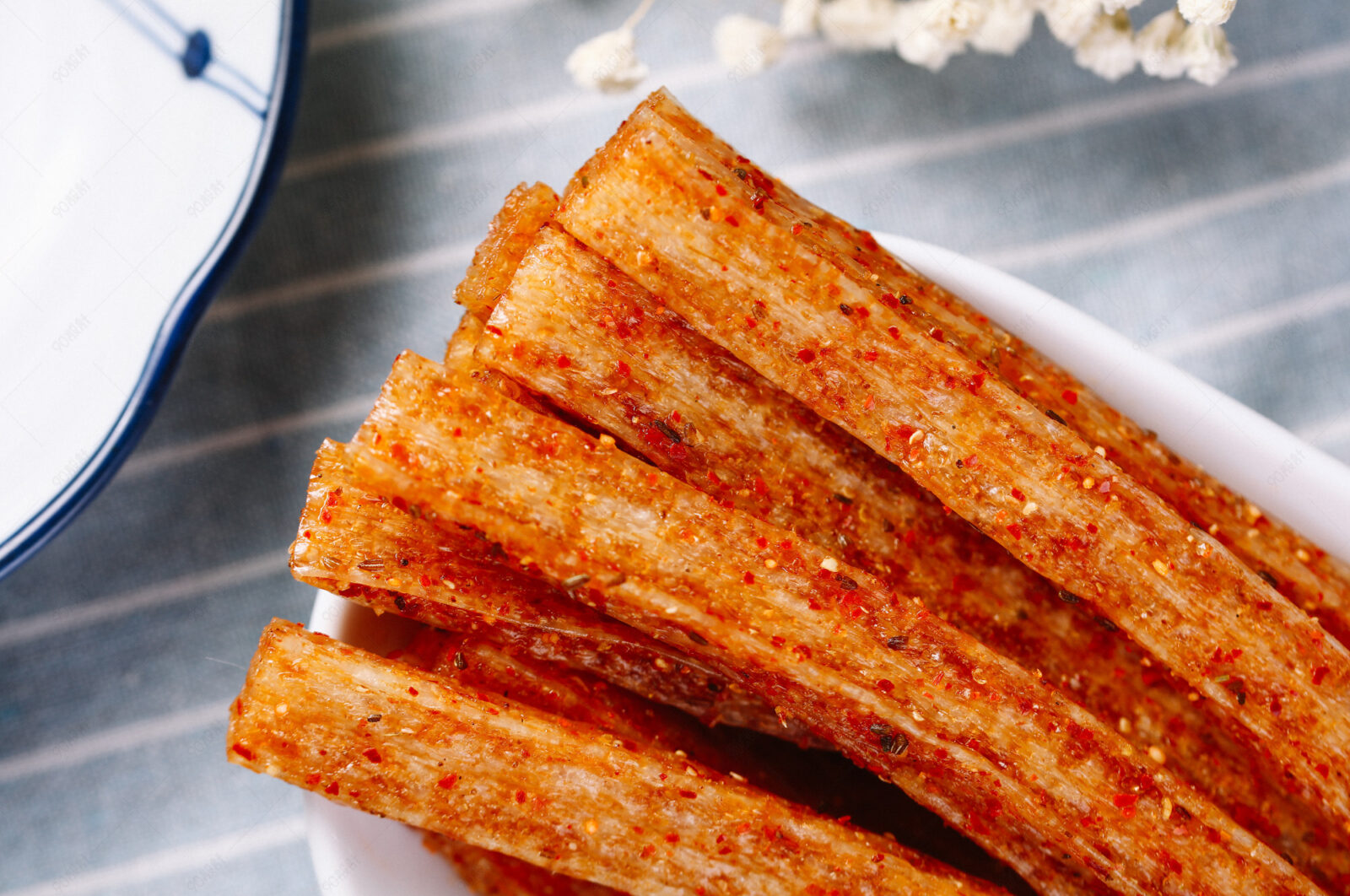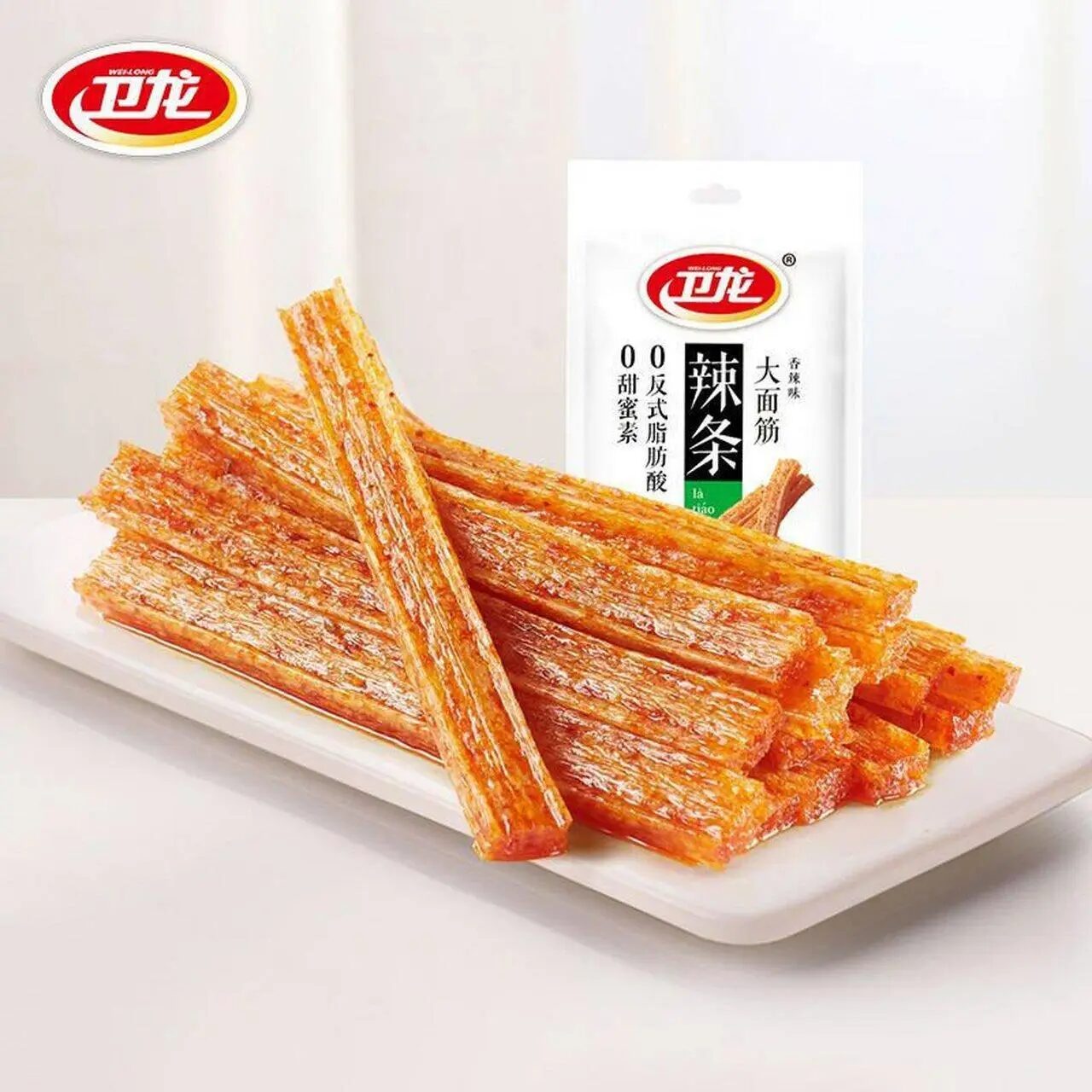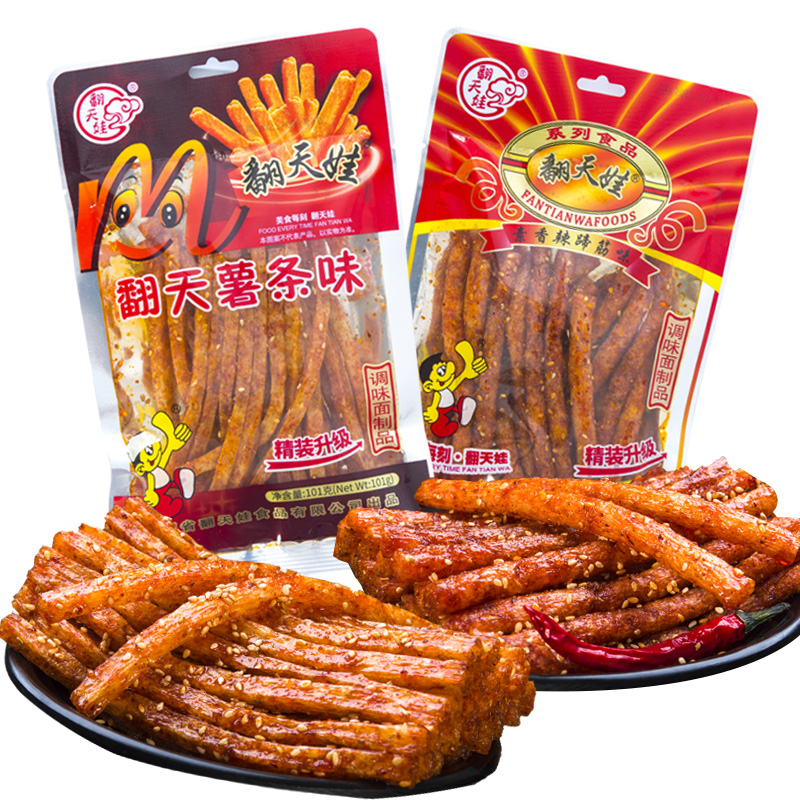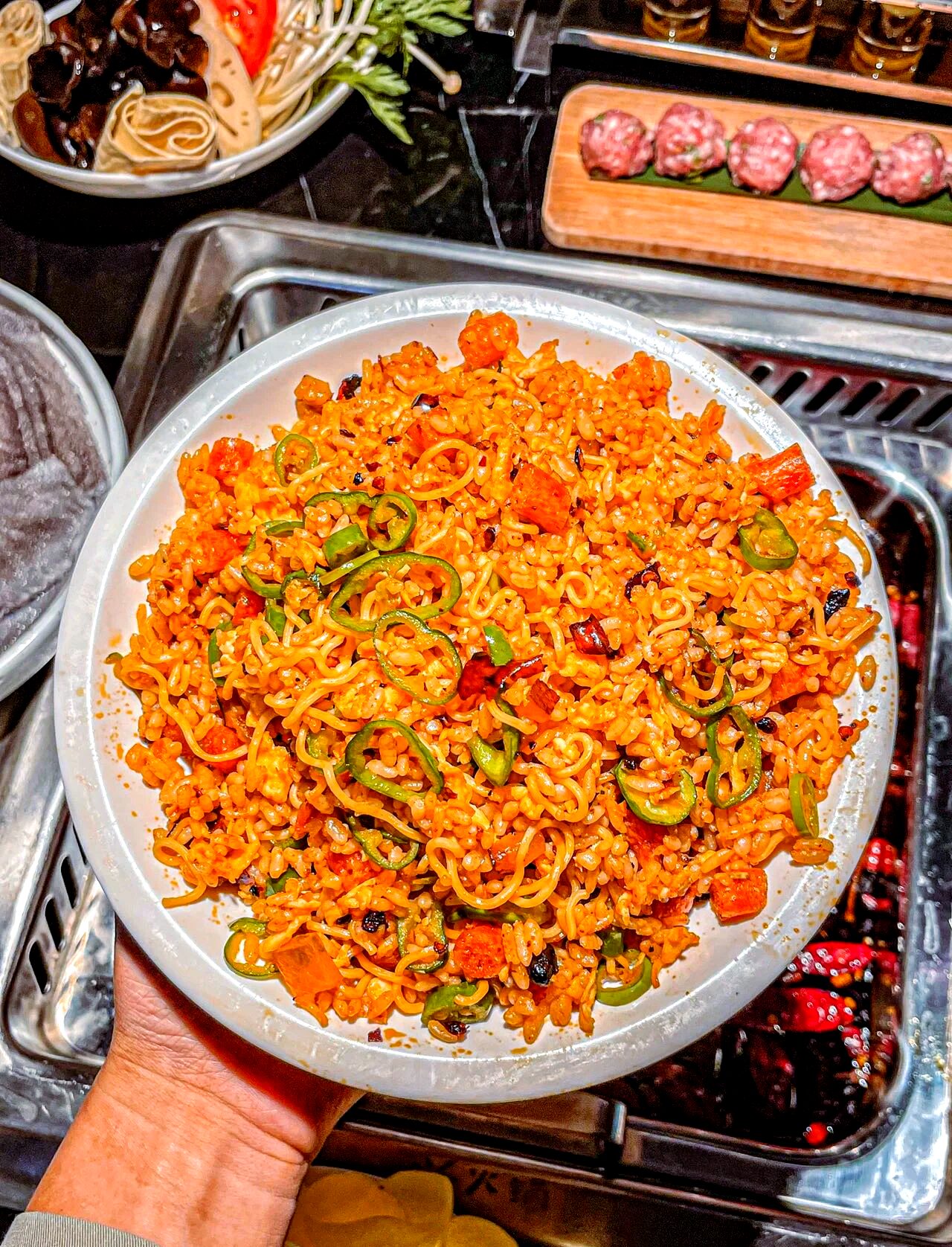Some snacks are just snacks. But la tiao? This one messes with your head. It’s salty, spicy, chewy—like your tongue just ran into a firecracker wrapped in soy sauce. People in China eat it in class, on buses, after dinner, before breakfast. There’s something dangerously addictive about it. First bite, you think, “Okay, weird.” Second bite? You’re hooked.

Spicy La Tiao
La Tiao and Its Cultural Rise
La tiao isn’t just a snack—it’s a shared memory, one you’ll find in schoolbags, night markets, and corner shops with sticky glass counters. Born in Hunan, or so most people say, this spicy gluten strip gained fame not from clever ads, but from a crisis. In 1998, when floods hit the province hard, locals ran out of soybeans—the main ingredient for snacks at the time. Factories turned to wheat gluten, mixed it with chili oil, and something oddly addictive came out. It was cheap, spicy, and didn’t go bad quickly. And somehow... it stuck.
Try biting into one now. There’s that rubbery chew, followed by salt, heat, and a faint sweetness if you’re paying attention. A Reddit user once said it “tastes like if jerky and rubber bands had a chili-covered baby”—which isn’t flattering, but also not wrong.
Different regions made it their own. Hunan’s is fierce and dry, Sichuan adds that tingling mala, and in Hubei, it’s weirdly sweet, like they dipped it in sugar water before packing. Each version fights for your tongue, and somehow they all win in their own way.
Top La Tiao Brands
Weilong – Classic, Clean, Controversial

Weilong Big Gluten La Tiao
Weilong is the name most people think of when you say la tiao. It’s everywhere—airports, vending machines, livestream hauls. Their packaging feels modern, sleek even, with shiny red wrappers and QR codes printed neatly next to cartoon flames. You’d almost forget it’s just spicy gluten.
The taste? It hits quick. Salty, oily, a bit smoky, then leaves a slow burn. Some say it’s too clean—too industrial compared to the messier stuff from local stalls. Others like that it doesn’t stain your fingers or reek up your bag.
But not everyone trusts it. After that 2019 food safety scandal, even though Weilong cleaned up and got certifications, some locals still say “Don’t eat Weilong”out of habit. It’s like the Coca-Cola of spicy strips—reliable, but maybe a little too polished for those who like their heat with chaos.
Mala Prince – Softer Bite, Youth Appeal

Mala Prince La Tiao
If Weilong is the big-name polished brand, Mala Prince feels more... playful. The first thing you notice is the packaging—it’s loud, cartoonish, almost like it’s trying to wink at you from a shelf. In some versions, the spice level is marked with a chili icon, but honestly, it's never too aggressive.
The texture is where it stands out. It’s softer, almost chewy in a relaxed way, which makes it perfect for people who like the idea of la tiao but can’t handle the full heat. Some folks even say it’s the one they’d pack for train rides—less messy, easy to tear.
You’ll spot it a lot near schools or small neighborhood groceries, sometimes next to stationery or bubble tea straws. It’s got that unmistakable “student snack” energy. Maybe not intense enough for chili addicts, but for casual nibbling? Pretty solid choice.
Fantianwa – Grassroots and Greasy, But Loved

Fantianwa La Tiao
Fantianwa isn’t fancy. The plastic wrap feels thin, like the kind that crinkles too loudly when you open it in class. Sometimes the logo’s a little off-center. And the oil? Yeah, there’s plenty. But that’s kind of the point.
You don’t buy this one for clean aesthetics. You get it because it tastes like childhood, or whatever childhood felt like when you had 2 RMB and a craving for something salty. The spice hits fast, but it doesn’t linger—more like a kick than a burn. It’s weirdly satisfying, even if halfway through your fingers look like they’ve been dipped in chili.
Where to Buy Abroad

Weilong Kiss Burn La Tiao
Finding la tiao outside China isn’t impossible—but it’s hit or miss, depending on where you are. In the U.S., head to 99 Ranch, H Mart, or small Chinese groceries hidden in strip malls. If you’re in London or Sydney, check Chinatown first. Ask the clerk, “Do you have spicy gluten strips?” and they might show you a random shelf between soy drinks and hotpot base. If you see shiny red packs with flames and bold characters like “Weilong” or “Mala Prince”,you’re probably in the right spot.
Online? Amazon sometimes stocks it, but watch out. Some listings are overpriced or worse—fake. One seller even used the wrong font on the Weilong logo. Platforms like Yamibuy or Shopee (in Southeast Asia) are safer bets, but shipping isn’t cheap.
Shelf Life and Storage
Most la tiao you buy in stores—especially the sealed ones from brands like Weilong—come with a shelf life of 6 to 12 months. But honestly, once you open the pack, the clock ticks faster. If the strip looks unusually dark, feels sticky in a weird way, or smells like burnt oil left overnight, it’s probably time to toss it.
For small packs, tossing them in a drawer is fine—as long as it's cool and dry. But with those big family-sized bags? You’ll want to seal them tight, maybe even keep them in the fridge if you’re in a humid place. The oil gets funky fast.
Homemade la tiao? Totally different story. Since there’s no preservative, you’ve got maybe 2 to 3 days, tops. Keep it in an airtight box and hope your friends don’t find it first. Honestly, that version never lasts long anyway—not because of spoilage, just because people eat it too fast.

La Tiao Fried Rice
The Ingredients You’ll Need (and Where to Find Them)
Making la tiao at home sounds like a wild idea—until you actually try it. What you’ll need? Just some all-purpose flour, maybe mix in a bit of high-gluten flour if you want that signature chew. Then there’s the fun stuff: chili oil, Sichuan peppercorn, garlic powder, maybe even a dash of MSG if you’re not judging yourself too hard.
Most of this you can grab at any Asian grocery store, or order online from places like Amazon or Weee!. The spices matter more than you think—cheap chili powder gives off a flat heat, while good oil leaves a numbing tingling on your lips.
The process? Honestly, messy. You knead the dough, stretch it into strips, steam them (or air-fry, if you’re modern), then soak them in spicy oil till they glisten. Your kitchen will smell like a back-alley snack stall for hours—and weirdly, that’s the best part.
Curious about how la tiao is actually made? This guide goes deeper than you’d expect.
Best Pairings: From Ramen to Cola
La tiao doesn’t have to be a standalone snack—it’s weirdly versatile. Some folks crush it up and sprinkle it over instant noodles, letting the heat mix with the soup base. Others swear by adding strips into rice stir-fry, especially the slightly oily ones that melt a bit into the pan. It adds this spicy, chewy surprise that hits better than store-bought sauces.
One Reddit user mentioned wrapping it in a slice of bread with mayonnaise and shredded lettuce—“junk food sushi,” they called it. Sounds unhinged, but also… not terrible? Then there’s the classic: milk tea and la tiao, especially if the drink has boba. The sweetness cools the spice, and somehow they balance each other out.
And of course—Cola. Not fancy sparkling water or soda with basil leaves. Just cold, fizzy cola straight from the fridge. It’s trashy in the best way, and after a bite of chili, that fizz feels like a rescue mission for your tongue
Ingredients and Food Safety
Let’s clear one thing up first—la tiao is not meat, even though it kinda looks like dried beef strips. Most are made from wheat gluten, mixed with chili oil, salt, and a cocktail of flavor enhancers. That chewy bite? That’s pure gluten doing its thing. Some brands add preservatives like sorbic acid, which is technically safe in small amounts—but yeah, it sounds a bit intense.
Back in 2019, Weilong got caught in a food safety mess—low-quality ingredients, dirty production lines, the works. Since then, things have tightened up, especially with new packaging standards and regular inspections. You’ll notice newer packs with clear expiration dates and official-looking seals.
Still, not all la tiao is equal. Some say “vegetarian” or “纯素” on the label, but sneak in chicken powder for flavor. If you’re vegan or Muslim, don’t assume—read the ingredients list, even if it means scanning with Google Translate. Some snacks look harmless but hide weird stuff in fine print.
Frequently Asked Questions (FAQs)
Q: Are there any sweet or non-spicy versions of la tiao?
While la tiao is famously spicy, there are a few sweet or milder versions floating around—especially in local Chinese markets. Some brands now make honey-glazed or five-spice variations, targeting younger kids or snackers who can't handle heat. These versions are less common abroad but might pop up in Asian supermarkets if you're lucky. Just check the ingredient list—the word “香辣” means spicy, while “甜味” is sweet.
Q: Can I bring la tiao into other countries through customs?
Generally, yes—especially if it's sealed and doesn’t contain meat. Since most la tiao is wheat-based, it usually passes customs inspections. But rules vary. For example, Australia and New Zealand are super strict about food imports, so even vegetarian snacks might get flagged. Always declare packaged food and check local guidelines. If it’s homemade la tiao, you’re probably better off eating it before you land.
Q: Do people in China still eat la tiao, or is it just nostalgia now?
Oh, people absolutely still eat it—especially students, late-night gamers, and anyone grabbing snacks at a corner store. It’s not just nostalgia, though that plays a part. Newer brands and upgraded packaging have made la tiao more acceptable as a “real” snack, not just a guilty one. It even shows up in fancy online gift boxes now. So while it started as a throwback, it’s definitely still part of daily life.
Q4: Is there a halal-certified la tiao for Muslim consumers?
It’s tricky. Most mainstream la tiao brands are not officially halal-certified. Some may appear vegetarian but still include chicken powder or other flavorings that aren’t halal. A few smaller brands in China claim halal status, but the certifications aren’t always internationally recognized. If you're strict about halal standards, it's safest to skip it unless you can verify the source with a reliable authority.
Q: Why is la tiao so popular on social media?
Because it’s weird, cheap, dramatic, and instantly reactive—perfect for TikTok and YouTube. The way it looks, the unexpected spiciness, the chewy texture—it makes for great reaction content. Influencers love “Asian snack challenges,” and la tiao fits right in. It also has a sort of meme status in China: the snack everyone jokes about but secretly enjoys. That duality makes it strangely shareable.


